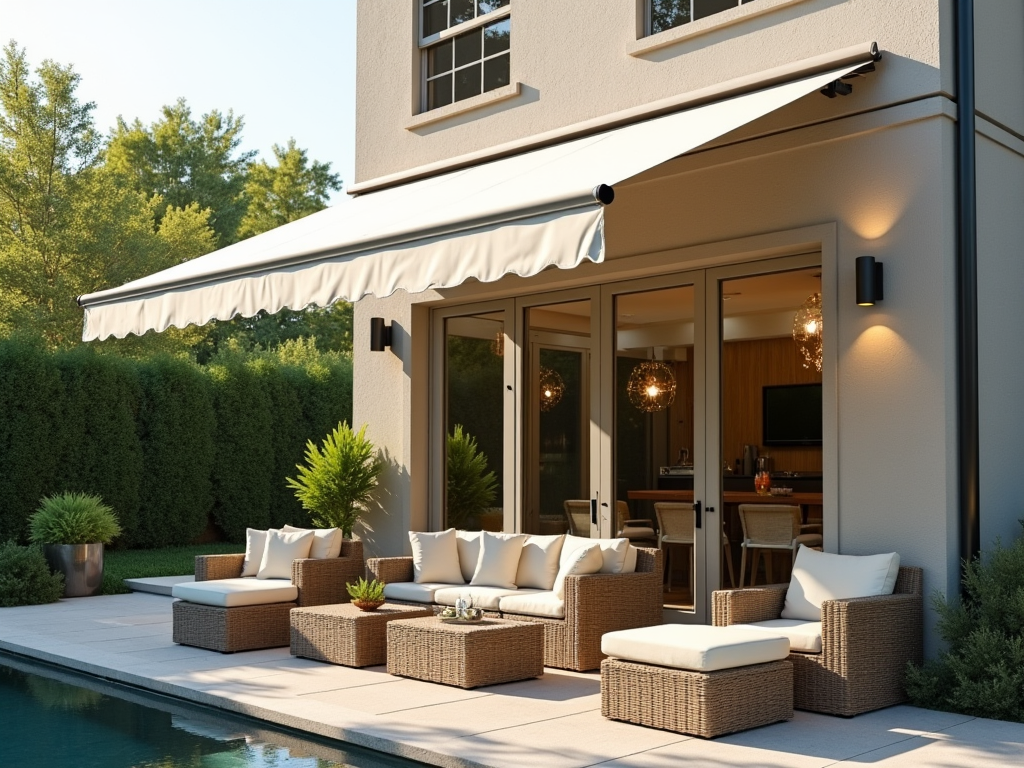Quick facts
Can't find the answer you're looking for? Please get in touch with our friendly team.
Are awnings worth the money?
Yes, awnings can be worth the investment. They provide shade, reduce energy costs by keeping indoor spaces cooler, and protect outdoor furniture from sun damage. Additionally, they can enhance your home's curb appeal and increase property value, making them a practical choice.
Why don't we use awnings anymore?
Awnings are less common now due to changes in design trends and the popularity of alternative shading solutions like pergolas and outdoor umbrellas. Additionally, modern materials and window treatments offer better energy efficiency and aesthetics, making awnings seem outdated for many homeowners.
What is an awning?
An awning is a secondary covering attached to the exterior wall of a building. It is typically made from canvas, acrylic, or vinyl and is used to provide shade and shelter from rain or sun. Awnings enhance outdoor spaces and can improve energy efficiency by keeping interiors cooler.
What is a permanent awning called?
A permanent awning is often referred to as a 'fixed awning.' These structures are typically made from durable materials like metal or fabric and are designed to provide long-term shade and protection from the elements, enhancing outdoor spaces like patios or entrances.
What is the average cost of a deck awning?
The average cost of a deck awning ranges from $1,500 to $3,500, depending on size, material, and installation. Retractable awnings may cost more, while fixed options can be less expensive. It's essential to consider quality and warranty when making a decision.
What is better than awnings?
Retractable canopies can be better than awnings as they offer flexibility. You can extend them when needed for shade and retract them for unobstructed views. Additionally, pergolas provide a stylish outdoor structure that enhances aesthetics while allowing for climbing plants to create natural shade.
Category Overview
Introduction
Awnings are an essential addition to any home, providing not just shade but also shelter and style. They enhance your outdoor and indoor spaces by creating a comfortable environment for relaxation or entertaining guests. Imagine enjoying a sunny afternoon under the canopy of an awning, free from the harsh glare of the sun or unexpected rain showers. With their functional utility and aesthetic appeal, awnings elevate everyday life, making your outdoor areas more inviting while adding a touch of decor that complements your home’s vibe.
Functionality
The primary functions of awnings revolve around protection and comfort. Whether installed over a patio, balcony, or window, they shield you from UV rays, rain, and other weather elements. This makes them ideal for outdoor living spaces like dining areas or lounging spots where you might want to enjoy the fresh air without worrying about the weather. In terms of versatility, awnings are often used in various contexts—from residential homes to commercial settings—providing shade for outdoor dining tables or even enhancing entryways with stylish coverings. Many modern awnings come with unique features such as retractability and adjustability, allowing you to customize the amount of sunlight or shade at any time. Whether you need tough coverage in windy areas or lightweight options for seasonal use, there's an awning that fits your needs.
Design & Style
Awnings come in various styles and materials that reflect personal taste and complement different architectural designs. Common materials include durable fabrics like acrylic or canvas for flexibility; metal options for lasting strength; and wood for a natural aesthetic appeal. You’ll find design variations ranging from traditional striped patterns to sleek minimalist designs that match contemporary decor themes such as mid-century modern or rustic farmhouse styles. Personalization is key; many manufacturers offer customizable color schemes and patterns so your awning can seamlessly integrate into your home's overall look—think vibrant hues for a fun backyard vibe or muted tones for a sophisticated touch. Moreover, integrating related items like "outdoor furniture sets" can further enhance the functionality and beauty of your space.
Practical Considerations
When selecting the right awning for your home, consider factors like room size and intended usage. For smaller patios or balconies, lighter fabric options may work better than heavy alternatives that can overwhelm limited space. Durability matters too; opt for fabrics treated against fading if you're in direct sunlight frequently. It's also vital to factor in design preferences—your choice should harmonize with existing elements in your home while serving its purpose effectively. Avoid common pitfalls like choosing an overly complicated installation system if you're not experienced with DIY projects; some models require professional installation to ensure safety and functionality. Maximizing functionality also includes understanding how much coverage you actually need: will it be mostly decorative or mainly protective? This decision will guide you toward the perfect fit for your lifestyle.
Comparison and Alternatives
When comparing materials, consider wood versus metal: wood provides warmth but may require more maintenance over time; metal offers durability but might lack aesthetic charm unless designed well. Similarly, round versus rectangular shapes can impact both appearance and practicality based on available space. Choosing between these styles involves weighing advantages: if aesthetics are paramount in a cozy garden setting, wooden options may suit best; if longevity against weather wear is your concern—as it often is—metal may be preferable.
Trends and Popular Items
Current trends have seen an increase in eco-friendly materials within the awning market as sustainability becomes more important to consumers. Additionally, there's been a noticeable rise in smart awnings equipped with sensors that automatically retract during inclement weather—adding convenience alongside style. Popular items now often boast UV-resistant fabrics combined with sleek designs echoing modernist principles—a nod towards both form and function alike! Embracing these trends can enhance not only visual appeal but also improve overall usability of outdoor spaces year-round. Incorporating these insights into your decisions helps ensure that what suits today's styles will remain practical tomorrow!


